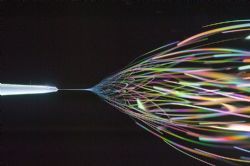Home > Press > High-tech nanofibres could help nutrients in food hit the spot
 |
Abstract:
New research outlines how the creation of ‘nanofibres’ could provide new and improved products and delivery systems for supplementary foodstuffs.
High-tech nanofibres could help nutrients in food hit the spot
Lincoln, UK | Posted on June 17th, 2015Nanofibre materials produced through a process called electrospinning are attracting particular attention in the food industry because of their potential to control the release of chemical constituents in the body.
Electrospinning uses an electrical charge to draw very fine (typically on the micro or nano scale) fibres from a liquid containing long-chain molecules – essentially providing a coating for health-promoting ingredients such as probiotics and vitamins. Electrospinning, and the related process of electrospraying, show promise as novel delivery vehicles for supplementary food compounds such as probiotics because they can be carried out at room temperature, with aqueous solutions and without complex coagulation chemistry. This means active ingredients can be better protected during the production process and as they pass through the digestive system.
In the journal Food Hydrocolloids, academics from the University of Lincoln, UK, and the Research Institute of Food Science & Technology in Iran present a comprehensive review of the fundamentals of electrospinning to produce nanofibres suitable for food technology application.
Co-author Dr Nick Tucker from the School of Engineering, University of Lincoln, has worked on nanofibre production and sustainable packaging materials for a number of years, having previously worked with the New Zealand seafood industry and Auckland Medical School to make skin scaffolds.
Dr Tucker said: “In this paper we aim to advance the design and performance of novel products and delivery systems for supplementary food compounds.
“Different methods have been suggested, examined and applied to encapsulate and dry probiotics and bioactive compounds to protect or even enhance their survival while passing through the upper gastro-intestinal tract. However, the harsh processing conditions of methods such as spray-drying can significantly reduce the viability of bacteria or damage the structure of the target molecules.
“Electrospun nanofibres can be used as the delivery system in foods for nutrients to protect them during the processing and storage or in delivery systems for transferring the components to the target site in the body. But to optimise production conditions and maximise quantity of nanofibres, a clear understanding of the mechanism of electrospinning is essential.”
Dr Tucker, who is looking to form industrial relationships to create electrospun composites for a number of applications, believes that greater collaboration between academia and industry will stimulate future developments.
He explains: “A critical assessment of the weakness and strength points of electrospinning technologies for industrial processes would certainly be useful. Moreover, the electrospun fibres will need parallel development of both their physical form, and methods of incorporation into food stuffs. This will take a considerable development effort if the advantages of these materials are to be incorporated in the functional foods of the near future.”
####
For more information, please click here
Contacts:
Marie Daniels - PR Officer
Telephone: +44 01522 886244
Copyright © University of Lincoln
If you have a comment, please Contact us.Issuers of news releases, not 7th Wave, Inc. or Nanotechnology Now, are solely responsible for the accuracy of the content.
| Related News Press |
News and information
![]() Researchers develop molecular qubits that communicate at telecom frequencies October 3rd, 2025
Researchers develop molecular qubits that communicate at telecom frequencies October 3rd, 2025
![]() Next-generation quantum communication October 3rd, 2025
Next-generation quantum communication October 3rd, 2025
![]() "Nanoreactor" cage uses visible light for catalytic and ultra-selective cross-cycloadditions October 3rd, 2025
"Nanoreactor" cage uses visible light for catalytic and ultra-selective cross-cycloadditions October 3rd, 2025
Discoveries
![]() Researchers develop molecular qubits that communicate at telecom frequencies October 3rd, 2025
Researchers develop molecular qubits that communicate at telecom frequencies October 3rd, 2025
![]() Next-generation quantum communication October 3rd, 2025
Next-generation quantum communication October 3rd, 2025
![]() "Nanoreactor" cage uses visible light for catalytic and ultra-selective cross-cycloadditions October 3rd, 2025
"Nanoreactor" cage uses visible light for catalytic and ultra-selective cross-cycloadditions October 3rd, 2025
Announcements
![]() Rice membrane extracts lithium from brines with greater speed, less waste October 3rd, 2025
Rice membrane extracts lithium from brines with greater speed, less waste October 3rd, 2025
![]() Researchers develop molecular qubits that communicate at telecom frequencies October 3rd, 2025
Researchers develop molecular qubits that communicate at telecom frequencies October 3rd, 2025
![]() Next-generation quantum communication October 3rd, 2025
Next-generation quantum communication October 3rd, 2025
![]() "Nanoreactor" cage uses visible light for catalytic and ultra-selective cross-cycloadditions October 3rd, 2025
"Nanoreactor" cage uses visible light for catalytic and ultra-selective cross-cycloadditions October 3rd, 2025
Patents/IP/Tech Transfer/Licensing
![]() Getting drugs across the blood-brain barrier using nanoparticles March 3rd, 2023
Getting drugs across the blood-brain barrier using nanoparticles March 3rd, 2023
![]() Metasurfaces control polarized light at will: New research unlocks the hidden potential of metasurfaces August 13th, 2021
Metasurfaces control polarized light at will: New research unlocks the hidden potential of metasurfaces August 13th, 2021
![]() Arrowhead Pharmaceuticals Announces Closing of Agreement with Takeda November 27th, 2020
Arrowhead Pharmaceuticals Announces Closing of Agreement with Takeda November 27th, 2020
Food/Agriculture/Supplements
![]() New imaging approach transforms study of bacterial biofilms August 8th, 2025
New imaging approach transforms study of bacterial biofilms August 8th, 2025
![]() SMART researchers pioneer first-of-its-kind nanosensor for real-time iron detection in plants February 28th, 2025
SMART researchers pioneer first-of-its-kind nanosensor for real-time iron detection in plants February 28th, 2025
![]() Silver nanoparticles: guaranteeing antimicrobial safe-tea November 17th, 2023
Silver nanoparticles: guaranteeing antimicrobial safe-tea November 17th, 2023
|
|
||
|
|
||
| The latest news from around the world, FREE | ||
|
|
||
|
|
||
| Premium Products | ||
|
|
||
|
Only the news you want to read!
Learn More |
||
|
|
||
|
Full-service, expert consulting
Learn More |
||
|
|
||








